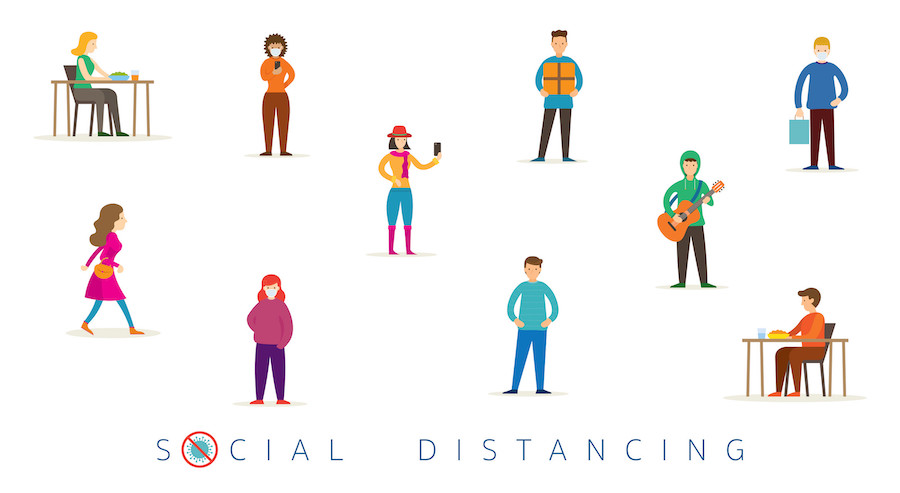How to activate your workplace during social distancing

Let’s be honest, working during social distancing isn’t easy.
Sure, there are the perks of having autonomy, personal snack bar (e.g. your kitchen), and maybe a feline coworker. But the perks of “WFH” can wear off quickly, as social interaction is central to any job.
When a team is separated or disparate to begin with, some workers find it difficult to reach their potential when office camaraderie is out of reach.
Focus, productivity, and motivation can wane without a way to stay connected, receive affirmation, direction, and ultimately meaning in our shared endeavors.
In a way, many companies pre-adapted by already having various communication and advocacy platforms in place.
And in general, the workplace is continuing to evolve and we’ve seen digital transformation continue to revolutionize how people are staying connected and working.
This applies to remote workers or companies who have physically distributed — and in many cases — global office locations. Creating a unified workplace where everyone is staying informed and connected can be challenging but is of the utmost importance.
And of course all of this becomes even more important when we’re faced with tough macro/global events that require more employees to work from home.
Something we have seen with some past and current outbreaks of viruses such as SARS, Swine Flu, and now the Coronavirus 2019 (COVID-19).
But with the right technology, employees can continue to be activated and productive from anywhere in the world.
What Do We Mean By “Activating Employees?”
The term “Employee Activation” may be somewhat new to you, but it’s also an industry buzz phrase that is starting to gain legitimate attention.
Essentially, when your employees are activated they are more engaged, productive, and are helping establish your company as a leader in whatever industry.
Activation is loosely understood as personal investment, when employees are compelled by their own volition to put their “skin in the game” so to speak.
Where the rubber meets the road however, employee activation is about motivating and encouraging employees to create and share content with their social networks and internally with their colleagues or business leaders.
And when you trust your employees by empowering them with the right platforms and showing how their voices matter, they’re more likely to trust your company.
Where employee activation is helping:
- Increased and improve brand reputation
- Helps attract more top talent
- Employee retention increases
- Authentic storytelling
- More sales and marketing results
Staying Connected, Informed, and Productive
According to this article from Flexjobs, “Between 2005 to 2017, there was a 159% increase in remote work. In 2015, 3.9 million U.S. workers were working remotely. Today that number is at 4.7 million, or 3.4% of the population.”
More than ever, distributed teams and remote work capabilities (and demand) is growing.
The challenge for many organizations is ensuring the work is getting done, employees are paying attention to their job duties, and that they are informed about the company news and happenings.
Yet, those fears are continuing to slow down and more companies (even the Fortune 500) are more open to remote work.
A large part is due to technology, which allows teams to work from anywhere in the world. And many of these “tools” you may use and should know like Zoom, Slack, Asana, Dropbox, Google Drive, Basecamp, and Evernote.
But many companies are not still paying attention to employee advocacy programs, which can keep teams in the office activated, but also global teams and remote workers.
I like to think that an employee advocacy program keeps your people connected, informed, and productive. So what does this mean?
Connected
In order for teams to feel engaged and part of their company, they need to be more connected with one another.
For remote work and distributed teams, this means being able to put a face to people they work with and get to know them even if they aren’t in the office together.
Employee advocacy platforms create a place where you can follow other colleagues, tag them on specific content, see their interests and ideas, and begin to feel like a community.
Informed
How everyone consumes information is different, but a lack of internal communication impacts how engaged and motivated employees feel.
The employee advocacy platform acts as the central location for all company news, information, and ideas.
And not only is information coming from the company leaders, but employees from all different backgrounds can share knowledge and better inform one another.
With mobile applications, email capabilities, and push notifications — employees will always be able to stay informed and help others as well.
Productive
You might be thinking that social media and all this information could be a distraction to the overall individual’s work, right?
But besides the benefits of a more informed and connected workplace, employees are still able to be productive in their work.
Groups can be created based on teams where projects and information can be discussed. That way, only the people who need to see this information will and it won’t distract others.
And besides the obvious communications value at the company-level, employee advocacy platforms help drive marketing, sales, and recruiting too.
As your organizing content and information, employees are able to share and create content to distribute internally and externally as well.
When employees are sharing and creating for external use, it helps drive more brand reach, leads, and web traffic.
For sales, it helps create more opportunities and increases the pipeline. After all, you are sharing information and creating value to potential prospects.
And when it comes to recruiting, it helps audiences and networks see the work culture, employee stories, and open job positions easier.
In general, employee advocacy platforms allow those departments to boost their efforts and work together with other departments that can mutually benefit one another.
Final Thoughts
Employee advocacy ultimately leads to more collaboration and workplace community.
This is only one piece to the puzzle when working remotely or with distributed teams. But it’s a solution for many business challenges, which organizations tend to neglect and overlook.
If you have a global team, want to connect your remote workers further, or are considering remote work but aren’t sure how to keep them connected — employee advocacy might be the perfect answer.
___
by Todd Kunsman
source: B2C

